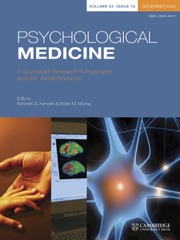Article contents
Genetic liability to suicidal thoughts and behaviors and risk of suicide attempt in US military veterans: moderating effects of cumulative trauma burden
Published online by Cambridge University Press: 29 November 2022
Abstract
Little is known about environmental factors that may influence associations between genetic liability to suicidality and suicidal behavior.
This study examined whether a suicidality polygenic risk score (PRS) derived from a large genome-wide association study (N = 122,935) was associated with suicide attempts in a population-based sample of European-American US military veterans (N = 1664; 92.5% male), and whether cumulative lifetime trauma exposure moderated this association.
Eighty-five veterans (weighted 6.3%) reported a history of suicide attempt. After adjusting for sociodemographic and psychiatric characteristics, suicidality PRS was associated with lifetime suicide attempt (odds ratio 2.65; 95% CI 1.37–5.11). A significant suicidality PRS-by-trauma exposure interaction emerged, such that veterans with higher levels of suicidality PRS and greater trauma burden had the highest probability of lifetime suicide attempt (16.6%), whereas the probability of attempts was substantially lower among those with high suicidality PRS and low trauma exposure (1.4%). The PRS-by-trauma interaction effect was enriched for genes implicated in cellular and developmental processes, and nervous system development, with variants annotated to the DAB2 and SPNS2 genes, which are implicated in inflammatory processes. Drug repurposing analyses revealed upregulation of suicide gene-sets in the context of medrysone, a drug targeting chronic inflammation, and clofibrate, a triacylglyceride level lowering agent.
Results suggest that genetic liability to suicidality is associated with increased risk of suicide attempt among veterans, particularly in the presence of high levels of cumulative trauma exposure. Additional research is warranted to investigate whether incorporation of genomic information may improve suicide prediction models.
- Type
- Original Article
- Information
- Copyright
- Copyright © The Author(s), 2022. Published by Cambridge University Press
References
- 3
- Cited by





